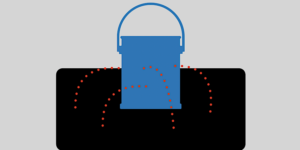Churn keeps everyone at Netflix and Apple TV up at night; it’s also crushing radio…

By Paul Marszalek
TheTop22.com
You do it, I do it, everyone is doing it – subscribing and canceling our TV subscriptions based on who’s got what, and who might be offering a better deal.
It’s called churn, and while hardly new to the subscription model, or any business for that matter, it’s used to describe the constant bleed of customers — and the efforts to either bring them back or replace them.
Churn can be visualized as a leaking bucket — as customers slip away, you either plug the holes or refill the bucket faster than it leaks.
It’s an extremely expensive problem, and those who are better at controlling churn are much more likely to survive and flourish.
For example, in the streaming TV space, top tier player Netflix has a churn rate of about 2.4%. Disney is next at 4.3%.
But then things get ugly: Peacock churns at 9.5%, and the content-starved Apple TV has a whopping churn of 15.6%. Imagine trying to hit your growth targets when you’re bleeding current customers at that rate.
In April of this year, churn was estimated to have cost TV streamers a collective $80 million. Just April.
Even though terrestrial radio doesn’t have a subscription model, it’s hardly immune from audience churn and the financial penalties it brings.
Not only do listeners churn from one station to another, they churn to other mediums based on myriad factors: News cycle, sports seasons, summer vacations, and COVID commute and work disruptions, just to name a few.
Customers drift away and need to be replaced or brought back into the fold. What to do?
TV streamers go to battle, pouring money into content development, acquisition, and star power – and combine that with heavy marketing and promotions.
Netflix spent $17 billion on content alone in 2020, and then spent $2.3 billion marketing it. That’s going to be $20 billion a year. Every year.
How does radio plug the holes and/or refill its leaking bucket?
This is where things diverge. Unlike Netflix or HBO’s focus on great content, radio does virtually nothing.
This week, iHeart re-signed Ryan Seacrest to a three year deal. We’re happy to see the investment. But can you think of any others off the top of your head?
How about marketing?
In public radio, marketing is anathema as many feel it improper to use donor money on “promotion” (it’s not, it’s customer acquisition). Public radio management also seems to have a self-imposed rule against star power. It’s incredibly counterproductive, allowing public radio-friendly superstars such as John Oliver, John Stewart, Trevor Noah and their many available talented-but-less-famous peers make it in other mediums such as TV or podcasts.
Commercial radio? Talent acquisition and marketing are line items of the past.
Until that changes, expect the leaks to continue.
 -The Top 22 – Triple A, Indie, Alternative Rock
-The Top 22 – Triple A, Indie, Alternative Rock

